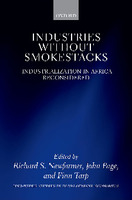Industries without Smokestacks
Industrialization in Africa Reconsidered
| dc.contributor.editor | Newfarmer, Richard | |
| dc.contributor.editor | Page, John | |
| dc.contributor.editor | Tarp, Finn | |
| dc.date.accessioned | 2019-05-13 14:21:01 | |
| dc.date.accessioned | 2020-04-01T10:27:32Z | |
| dc.date.available | 2020-04-01T10:27:32Z | |
| dc.date.issued | 2019 | |
| dc.identifier | 1004965 | |
| dc.identifier | OCN: 1135847415 | en_US |
| dc.identifier.uri | http://library.oapen.org/handle/20.500.12657/25128 | |
| dc.description.abstract | Structural transformation in Africa has become a hot topic. One of the earliest stylized facts of development economics is that low-income countries have large differences in output per worker across sectors, and movement of workers from low- to high-productivity sectors—structural transformation is a key driver of economic growth. Between 1950 and 2006, about half of the catch-up by developing countries—led by East Asia—to advanced economy productivity levels was due to rising productivity within manufacturing combined with structural transformation out of agriculture. Manufacturing has the capacity to employ large numbers of unskilled workers, is capable of large productivity gains through innovation, and entails tradeable products that permit economies of scale and specialization. But manufacturing in Africa, rather than leading growth, has typically been a lagging sector. In 2014, the average share of manufacturing in GDP in sub-Saharan Africa hovered around 10 per cent, unchanged from the 1970s, leading some observers to be pessimistic about Africa’s potential to catch the wave of sustained rapid growth and rising incomes. This book challenges that view. It argues that other activities sharing the characteristics of manufacturing—including tourism, ICT, and other services as well as food processing and horticulture—are beginning to play a role analogous to the role that manufacturing played in East Asia. This reflects not only changes in the global organization of industries since the early era of rapid East Asian growth, but also advantages unique to Africa. These ‘industries without smokestacks’ offer new opportunities for Africa to grow in coming decades. | |
| dc.language | English | |
| dc.relation.ispartofseries | WIDER Studies in Development Economics | |
| dc.subject.classification | thema EDItEUR::K Economics, Finance, Business and Management::KC Economics | en_US |
| dc.subject.classification | thema EDItEUR::K Economics, Finance, Business and Management::KN Industry and industrial studies | en_US |
| dc.subject.classification | thema EDItEUR::K Economics, Finance, Business and Management::KN Industry and industrial studies::KND Manufacturing industries | en_US |
| dc.subject.other | Africa | |
| dc.subject.other | structural transformation | |
| dc.subject.other | industries without smokestacks | |
| dc.subject.other | economic growth | |
| dc.subject.other | manufacturing | |
| dc.title | Industries without Smokestacks | |
| dc.title.alternative | Industrialization in Africa Reconsidered | |
| dc.type | book | |
| oapen.identifier.doi | 10.1093/oso/9780198821885.001.0001 | |
| oapen.relation.isPublishedBy | b9501915-cdee-4f2a-8030-9c0b187854b2 | |
| oapen.relation.isFundedBy | c9be6ad3-6692-452d-a1f3-a3e6c74f0fe2 | |
| oapen.relation.isbn | 9780198821885 | |
| oapen.pages | 480 | |
| oapen.place.publication | Oxford, UK | |
| oapen.identifier.ocn | 1135847415 |

